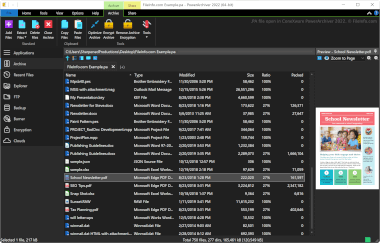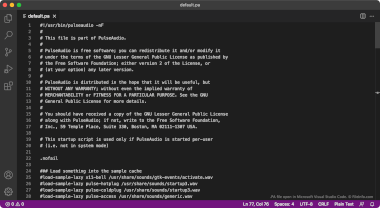.PA File Extension
PowerArchiver Compressed File
| Developer | ConeXware |
| Popularity |
3.4 | 5 Votes |
What is a PA file?
A PA file is a compressed archive created by ConeXware PowerArchiver, a utility used to compress, encrypt, and back up data. It stores one or more files compressed with the Advanced Codec Pack (PA) format, which includes various advanced filters and codecs for optimizing compression based on the file type, and may include FIPS 140-2 256-bit AES encryption. PowerArchiver users compress files as PA archives to save space for storage or transportation purposes and secure sensitive information.
More Information
ConeXware PowerArchiver is a utility for compressing, encrypting, and backing up data in Windows and macOS. The utility supports over 60 archive formats, besides the PA format, including .ZIP, .RAR, .7Z, .LZH, .GZIP, and .ARC.
PowerArchiver Advanced Codec Pack Format
ConeXware introduced the PowerArchiver Advanced Codec Pack format when it released PowerArchiver 2017. The format features two optimized compression modes: 1) "Optimized Fast" for faster compression and 2) "Optimized Strong" for stronger compression.
PowerArchiver uses the BWTS algorithm to mix data before AES encryption to better secure archives. This encryption method results in archives that are better protected than ZIP and 7Z AES archive formats.
How to open a PA file
You can open a PA file with ConeXware PowerArchiver in Windows and macOS. To open a PA file, select File → Open Archive.
How to convert a PA file
ConeXware PowerArchiver (Windows version only) can convert PA files to various archive types, including the following formats:
Programs that open PA files
PulseAudio Startup Script
| Developer | PulseAudio Community |
| Popularity |
3.7 | 3 Votes |
A PA file may also be a configuration file used by PulseAudio, a free sound server program. It is run at startup to specify how a user's sound system is configured. PulseAudio's primary PA file is named default.pa.
More Information
PulseAudio is a program used to manage how a computer outputs audio. For example, you can use PulseAudio to mix several audio streams and output them using one audio device, or you can use it to change audio's sample format or channel count. The program is available primarily for Linux, but macOS and Windows versions also exist.
At startup, PulseAudio loads settings that define how a user's audio system is set up from a PA file. In most cases, PulseAudio loads these settings from a file named default.pa, which is located at either ~/.config/pulse/default.pa or etc/pulse/default.pa. When PulseAudio runs as a system service, it instead loads settings from etc/pulse/system.pa.
NOTE: The Windows version of PulseAudio is no longer maintained.
Common PA Filenames
default.pa - PulseAudio's default startup script.
system.pa - PulseAudio's system service-level startup script.
How to open a PA file
PulseAudio's PA files are plain text files, so you can open and edit them in GitHub Atom, Apple TextEdit, Microsoft Notepad, or any other text editor. For example, you can edit default.pa to specify a new default audio output device. PulseAudio will then use that new default device the next time you start it.
Programs that open or reference PA files
Print Artist Project
| Developer | Nova Development |
| Popularity |
2.2 | 5 Votes |
Print project created with Print Artist, a graphic design program; typically designed from a template and may include custom graphics and text; may be a brochure, greeting card, calendar, scrapbook, poster, or other type of printable document.

